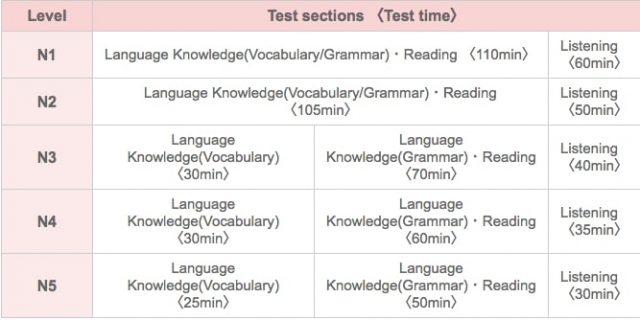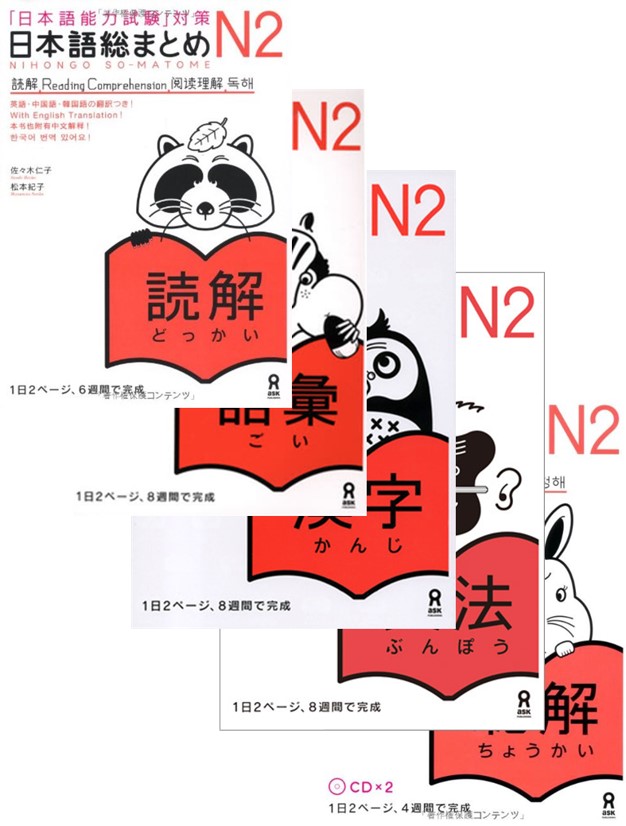JLPT N2 Exam Guide – Table of Contents:
- Background
- Components of the JLPT N2 Exam
- Kanji
- Grammar
- Reading
- Vocabulary
- Listening
- Keigo
- Japanese School
- Study Resources
- Taking the JLPT Exam
- Results
1. Background
The JLPT N2 level is considered a landmark achievement for those hoping to use Japanese in their careers. When applying for companies where some level of Japanese is required, N2 is often the benchmark for business level, while N1 is pretty much equivalent to native-level Japanese.
According to the statistics on the JLPT website, in July of 2017, the N2 level had the most number of applicants amongst all the levels at a total of 145,310 applicants. Of those applicants, 43.9% percent passed the exam.
2. Components of the JLPT N2 Exam
The JLPT N2 is broken down into three sections (listening, grammar/vocabulary, reading). Each section is worth 60 points and you must get 19 points or more in each section AND get a total of at least 100 points.


The good thing about this scoring system is that if you’re not very strong in a certain area (for me, kanji) then you can make up the points with your strengths (for me, listening).
As long as you get the minimum amount of points (19) in each section and get a total of at least 100 points, you’ll pass! But wait right there…it’s actually not that simple.
It’s not exactly clear how points are assigned throughout the exam. They use a complex formula where all questions are not weighted equally.
3. JLPT N2 Kanji
Oh, kanji…the bane of at least MY existence. It’s said that you need to know at least 1,000 kanji to pass N2. On top of that, each kanji always seems to have two or more readings…so it’s more like having to memorize 2,000 to 3,000 things! So, all of this kind of freaked me out and throughout the beginning of my studies, it took up a majority of my studying.
At first, I tried to memorize how to write out each kanji, but I soon realized that it was impossible. After that realization, I focused on just being able to recognize each kanji because in the end, you just want to be able to use your kanji knowledge to read.
It would take decades to be able to write out all the kanjis from memory and with technology’s continual advancement, it’s kind of a dying skill even amongst native Japanese people.
4. JLPT N2 Grammar
Now, I’ll be honest, I didn’t necessarily start from zero with the grammar. As my parents speak some Japanese, I picked up some Japanese grammar as a child. That being said, since I never formally went to Japanese school as a child, when I first started studying Japanese I didn’t even know how to conjugate verbs in Japanese. So, a lot of work needed to be done there.
For me, I thought the best way to learn grammar was through going to Japanese school. The teachers explain not only the grammar points, but in what types of situations you would use each grammar point.
They explain whether a particular grammar point is used only in writing, in formal situations, or in casual situations. That was something I couldn’t really get out of just studying grammar out of a book.
5. JLPT N2 Reading
Reading is the one area I really wish I had focused more on before I took the N2. I spent too much time memorizing kanji, that I didn’t focus enough on how each kanji was applied. I didn’t take into account how long it would take for me to get used to reading all the hiraganas, katakanas, and kanjis and piecing them all together to make sense of it all.
So, if there’s anything I could redo all over again, it would be to read more articles and books. Even if you don’t know enough kanjis, the more you try to read the more your brain just gets used to that practice and the quicker things will click down the line.
Unfortunately, I focused too much on studying each individual kanji and when it came down to taking the test, the reading passages were too long for me and I ran out of time.
6. JLPT N2 Vocabulary
Vocabulary is kind of like the kanji, where it’s just brut memorization unfortunately.
I found it nice to go to Japanese school because they would provide vocabulary words for each lesson and I would be studying my own vocabulary words. So, I felt that it was twice as effective.
7. JLPT N2 Listening
Listening was the last thing I studied before taking the N2. I think that of all the areas, this is the easiest to pick up just by watching Japanese dramas or anime or having conversations in Japanese.
The one thing that you definitely should do before taking the exam is take a listening practice exam. I found some just by searching “JLPT N2 listening” on YouTube. There are 4 to 5 sections in the listening exam and each section is a different format.
So it’s best if you are already prepared for each format because you don’t want to be wasting your time getting used to each format during the actual exam.
8. Keigo
Keigo is the formal form of the Japanese language. It’s often used in business and very formal situations, like speeches and ceremonies. It’s also another one of those bane of my existence kind of things because depending on if you’re talking about yourself or you’re talking about someone you want to respect, you use different verbs.
It gets quite complicated. Japanese school was the best way for me to learn keigo. Even when I tried to study keigo out of books, I couldn’t understand when to use each form.
So, taking a Japanese business course was the most efficient way to learn keigo. You can find out more about how to use keigo here.
9. Japanese School
In learning a new language, there are some things that you can study independently and some things that are best to just be taught. For me, kanji, listening and to some extent vocabulary were the things that I could study on my own.
On the contrary, grammar and keigo were things that I felt independent study was not as effective. With grammar and keigo, I needed someone to explain the nuances and lay out the situational uses of each grammar or keigo point.
Even to this day, I probably wouldn’t really understand certain grammar of keigo points without the help of my teachers.
Coto Japanese Academy Courses I took: 3.1 to 3.3 and Business Japanese
10. Study Resources
There are a lot of books out there for JLPT prepping, but here are the ones I used:
- Nihongo So-matome N2: Vocabulary, Kanji, Reading Comprehension, Grammar
- Nihongo So-matome N3: Vocabulary, Kanji, Reading Comprehension
- Shin Kanzen Masuta- N2: Reading Comprehension

11. Taking the JLPT Exam
Taking the exam can be a little nerve-wrecking too. I took mine in Tokyo and it was the first time taking an exam in Japan.
They were pretty strict and have a yellow card/red card system in place. If you open your booklet before the exam starts or continue doing the exam after it ends, you get a yellow card. I think 2 yellow cards, and you get thrown out…so make sure you listen to instructions.
Also, bring a watch because my classroom didn’t have a clock anywhere and they don’t give you a 5 or 10-minute warning. I saw some people panicking because they didn’t know how much time was left. So, I wouldn’t want that to happen to you.
12. Results
These are my scores for the N2 exam that I took in December of 2017. As mentioned before, there are 3 sections, vocabulary/grammar, reading and listening. Each section is worth 60 points and you must get 19 points or more in each section AND get a total of at least 100 points.
The reference information section is for vocabulary and grammar only. I think the reason they post it is because the points section is all based on their own complicated formulas, but with the reference information section you can at least get an idea of what percentage of the questions you got right.
A: The number of correct responses is 67% or higher.
B: The number of correct responses is between 34% and 66%.
C: The number of correct responses is less than 34%.
Click to tweet this article to help more Japanese learners!